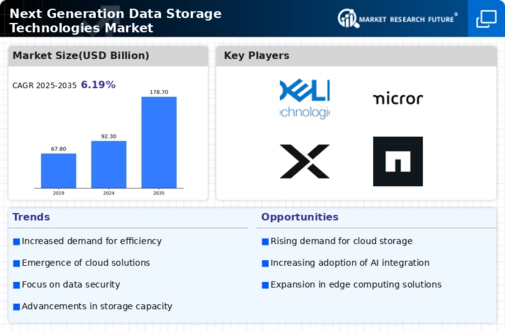Market Analysis
In-depth Analysis of Next Generation Data Storage Technologies Market Industry Landscape
The Next Generation Data Storage Technologies market is characterized by dynamic and ever-evolving market forces that significantly influence its trajectory. One of the primary market dynamics is the incessant growth of data generation across various sectors. As businesses and individuals continue to produce vast amounts of data, the demand for advanced data storage technologies experiences a consistent upward trend. This surge is fueled by the widespread adoption of digital technologies, the Internet of Things (IoT), and the integration of artificial intelligence, all of which contribute to the exponential increase in data volumes.
Technological advancements represent another crucial aspect of the market dynamics. The continuous evolution of storage mediums, including non-volatile memory technologies such as NAND flash and emerging innovations like 3D XPoint, propels the development of faster, more reliable, and energy-efficient storage solutions. These advancements not only enhance storage performance but also contribute to the overall efficiency of data processing systems, thereby shaping the competitive landscape of the market.
The market dynamics are also profoundly influenced by the heightened focus on data security and privacy. With the escalating frequency and sophistication of cyber threats, organizations are prioritizing storage solutions that offer robust security features. The integration of encryption, access controls, and secure data erasure mechanisms has become imperative to safeguard data integrity and confidentiality. As a result, the market is witnessing a continuous evolution of security features to address the ever-changing threat landscape.
Cost dynamics play a pivotal role in shaping the market. While there is a constant demand for high-capacity storage solutions, organizations are increasingly conscious of cost considerations. This has led to the rise of cost-effective options such as cloud-based storage services and software-defined storage solutions. These alternatives offer scalability and flexibility, providing organizations with the ability to manage their data efficiently while optimizing costs.
Interconnectivity and compatibility are essential market dynamics as well. As the trend towards distributed data storage and the adoption of hybrid or multi-cloud environments intensifies, seamless integration between storage systems becomes imperative. The market responds with solutions that prioritize compatibility, enabling organizations to manage and access their data seamlessly across diverse infrastructures. This interconnectivity facilitates efficient data management in complex and hybrid IT environments.
Sustainability considerations are gaining prominence in the market dynamics of Next Generation Data Storage Technologies. With an increasing emphasis on environmental responsibility, there is a growing demand for eco-friendly storage solutions. Companies are exploring energy-efficient storage devices, implementing recycling programs for end-of-life hardware, and adopting sustainable practices in manufacturing processes. This environmental consciousness is not only a response to market demand but also aligns with global efforts towards a more sustainable future.
Market competition is a driving force shaping the dynamics of the Next Generation Data Storage Technologies market. Companies engage in intense competition, deploying various strategies to gain a competitive edge. Product innovation, strategic partnerships, mergers and acquisitions, and effective marketing become crucial elements in navigating the competitive landscape. The dynamic nature of the market necessitates agility and adaptability on the part of market players to stay ahead in the race.







Leave a Comment